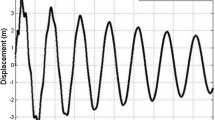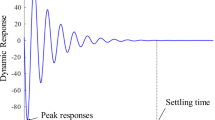Abstract
Purpose
This paper aims to address the limitations of the filtered-x least mean square (FXLMS) control algorithm in terms of significant noise in filtered results and hindered convergence and steady-state error reduction due to fixed-step size iterations.
Methods
In this study, a new adaptive filtering algorithm based on error weight is proposed. Multiple moment weight errors are introduced into the objective function, and the error weights are automatically calculated during the iterative process. The step size is optimized to accelerate convergence speed and curtail steady-state error. The state space equation and transfer function expression of the simply supported plate system are calculated, and a hybrid control algorithm for plate vibration control is designed.
Results
The proposed algorithm is simulated and compared with various existing variable step size algorithms and gradient-based least-squares (GLS) algorithms using Mathematica software. The simulation results demonstrate that the proposed algorithm achieves a convergence rate at least six iteration steps ahead of other algorithms, with a minimum reduction of 0.00405 in the average absolute error. This indicates the superiority of the proposed algorithm in terms of convergence speed and steady-state error reduction.
Conclusion
The proposed algorithm demonstrates clear advantages in enhancing the rate of convergence of the FXLMS control algorithm and reducing steady-state error. Future research can focus on reducing variable step input parameters and minimizing algorithmic computational complexity.











Similar content being viewed by others
Data availability
Data will be made available on request
References
Qiu J, Haraguchi M (2006) vibration control of a plate using a self-sensing piezoelectric actuator and an adaptive control approach. J Intel Mat Syst Str 17(8–9):661–669. https://doi.org/10.1177/1045389X06055760
Boz U, Basdogan I (2015) IIR filtering based adaptive active vibration control methodology with online secondary path modeling using PZT actuators. Smart Mater Struct 24(12):125001–125012. https://doi.org/10.1088/0964-1726/24/12/125001
Shivashankar P, Gopalakrishnan S (2020) Review on the use of piezoelectric materials for active vibration, noise, and flow control. Smart Mater Struct 29(5):53001. https://doi.org/10.1088/1361-665X/ab7541
Zhang Z, Hu F, Wang J (2010) On saturation suppression in adaptive vibration control. J Sound Vib 329(9):1209–1214. https://doi.org/10.1016/j.jsv.2009.11.027
Zheng H, Yang D, Xie X, Zhang Z (2020) An adaptive algorithm for active vibration control of parameter-varying systems with a new online secondary path estimation method. IEEE Signal Proc Let 27:705–709. https://doi.org/10.1109/LSP.2020.2986139
Gripp JAB, Rade DA (2018) Vibration and noise control using shunted piezoelectric transducers: a review. Mech Syst Signal Pr 112:359–383. https://doi.org/10.1016/j.ymssp.2018.04.041
Gupta V, Sharma M, Thakur N (2010) Optimization criteria for optimal placement of piezoelectric sensors and actuators on a smart structure: a technical review. J Intel Mat Syst Str 21(12):1227–1243. https://doi.org/10.1177/1045389X10381659
Phamila YAV, Amutha R (2014) Discrete cosine transform based fusion of multi-focus images for visual sensor networks. Signal Process 95:161–170. https://doi.org/10.1016/j.sigpro.2013.09.001
Xie L, Qiu Z, Zhang X (2016) Vibration control of a flexible clamped-clamped plate based on an improved FULMS algorithm and laser displacement measurement. Mech Syst Signal Pr 75:209–227. https://doi.org/10.1016/j.ymssp.2015.12.016
Mayyas K (2013) A variable step-size selective partial update LMS algorithm. Digit Signal Process 23(1):75–85. https://doi.org/10.1016/j.dsp.2012.09.004
Shi J, Zhang HD, Wu GH (2012) Variable step size LMS adaptive filtering based on genetic algorithm. Appl Mech Mater 263–266:2238–2243. https://doi.org/10.4028/www.scientific.net/AMM.263-266.2238
Pu Y, Zhang F, Jiang J (2014) A new online secondary path modeling method for adaptive active structure vibration control. Smart Mater Struct 23(6):1–12. https://doi.org/10.1088/0964-1726/23/6/065015
Li C, Mao C, Chen Z (2022) A novel adaptive control algorithm for the rejection of harmonics in a standard vibrator. J Vib Control 28(3–4):439–451. https://doi.org/10.1177/1077546320980200
Ren M, Xie X, Zhang Z (2022) Subband reinforced adaptive feedback control algorithm in mechanical vibration control. Control, J Vib. https://doi.org/10.1177/10775463211051451
Niu W, Zou C, Li B, Wang W (2019) Adaptive vibration suppression of time-varying structures with enhanced FxLMS algorithm. Mech Syst Signal Pr 118:93–107. https://doi.org/10.1016/j.ymssp.2018.08.009
Gu Y (2004) Superior step-size theorem and its application parallel variable step-size LMS filters algorithm, science in China. Series Inform sci 47(2):151–160. https://doi.org/10.1360/02yf0108
Krstajic B, Zecevic Z, Uskokovic Z (2013) Increasing convergence speed of FxLMS algorithm in white noise environment. AEU-Int J Elect C 67(10):848–853. https://doi.org/10.1016/j.aeue.2013.04.012
Gomathi K, Saravanan V (2016) Variable step size for improving convergence of FxLMS algorithm. Proced Technol 25:420–426. https://doi.org/10.1016/j.protcy.2016.08.127
Toftekær JF, Benjeddou A, Høgsberg J (2020) General numerical implementation of a new piezoelectric shunt tuning method based on the effective electromechanical coupling coefficient. Mech Adv Mater Struc 27(22):1908–1922. https://doi.org/10.1080/15376494.2018.1549297
Aridogan U, Basdogan I, Erturk A (2016) Random vibration energy harvesting on thin plates using multiple piezopatches. J Intel Mat Syst Str 27(20):2744–2756. https://doi.org/10.1177/1045389X16635846
Plattenburg J, Dreyer JT, Singh R (2015) Active and passive damping patches on a thin rectangular plate: a refined analytical model with experimental validation. J Sound Vib 353:75–95. https://doi.org/10.1016/j.jsv.2015.05.026
Yuxue P, Zeng M, Huanlin Z (2019) Design and implementation of multichannel adaptive active vibration control with online secondary path modeling using piezoelectric transducers patches. T I Meas Control 41(9):2496–2506. https://doi.org/10.1177/0142331218802618
Fang Y, Zhu X, Hu J, Gao Z, Zhang H (2020) Multi-frequency micro-vibration control with hybrid adaptive control algorithm. T I Meas Control 42(7):1417–1426. https://doi.org/10.1177/0142331219891578
Delegà R, Bernasconi G, Piroddi L (2017) A novel cost-effective parallel narrowband ANC system with local secondary-path estimation. J Sound Vib 401:311–325. https://doi.org/10.1016/j.jsv.2017.04.034
Ma B, Qiu Z, Zhang X, Han J (2016) Experiments on resonant vibration suppression of a piezoelectric flexible clamped–clamped plate using filtered-U least mean square algorithm. J Intel Mat Syst Str 27(2):166–194. https://doi.org/10.1177/1045389X14563867
Ma K (2003) Vibration control of smart structures with bonded PZT patches: novel adaptive filtering algorithm and hybrid control scheme. Smart Mater Struct 12(3):473–482. https://doi.org/10.1088/0964-1726/12/3/319
Yuanlian H, Yaqi A, Qi G, Peijun L (2022) Variable step size LMS algorithm based on inverse hyperbolic tangent function. Transact Beij Instit Technol 42(10):1051–1058. https://doi.org/10.15918/j.tbit1001-0645.2021.257
Clark RL, Fuller CR (1992) Optimal placement of piezoelectric actuators and polyvinylidene fluoride error sensors in active structural acoustic control approaches. J Acoust Soc Amer 92(3):1521–1533
Abdeljaber O, Avci O, Inman DJ (2016) Active vibration control of flexible cantilever plates using piezoelectric materials and artificial neural networks. J Sound Vib 363:33–53. https://doi.org/10.1016/j.jsv.2015.10.029
Wu T, Chen Z, Yan H, Qu J (2022) Optimization of the location of piezoelectric actuator and sensor in active vibration control using Multi-Verse Optimizer algorithm. J Intel Mat Syst Str 34(4):401–414. https://doi.org/10.1177/1045389X221111537
Donoso A, Bellido JC (2018) Robust design of multimodal piezoelectric transducers. Comput Method Appl M 338:27–40. https://doi.org/10.1016/j.cma.2018.04.016
Latrache M, Amrane MN (2017) The LQR control active of smart plate based on the finite element method. Period Polytech Mech Eng 61(2):115–121. https://doi.org/10.3311/PPme.9499
Ang KK, Wang SY, Quek ST (2002) Weighted energy linear quadratic regulator vibration control of piezoelectric composite plates. Smart Mater Struct 11(1):98–106
Fang Y, Zhu X, Gao Z, Hu J, Wu J (2019) New feedforward filtered-x least mean square algorithm with variable step size for active vibration control. J Low Freq Noise Vib Active Control 38(1):187–198. https://doi.org/10.1177/1461348418812326
Y. Zhang, and S. Xi, 2017 New LMS adaptive filtering algorithm with Variable step size International Conference on Vision, Image and Signal Processing, Osaka, Japan. Doi: https://doi.org/10.1109/ICVISP.2017.11.
Funding
This work was supported by the National Key R&D Program of China under Grant No. 2019YFE0116200.
Author information
Authors and Affiliations
Corresponding author
Ethics declarations
Conflict of Interest
The authors declared no potential conflicts of interest with respect to the research, authorship, and/or publication of this article.
Additional information
Publisher's Note
Springer Nature remains neutral with regard to jurisdictional claims in published maps and institutional affiliations.
Rights and permissions
Springer Nature or its licensor (e.g. a society or other partner) holds exclusive rights to this article under a publishing agreement with the author(s) or other rightsholder(s); author self-archiving of the accepted manuscript version of this article is solely governed by the terms of such publishing agreement and applicable law.
About this article
Cite this article
Wu, T., Chen, T., Yan, H. et al. An Improved FXLMS Algorithm Based on Error Weight for Active Vibration Control of Plates. J. Vib. Eng. Technol. 12, 3289–3303 (2024). https://doi.org/10.1007/s42417-023-01044-x
Received:
Revised:
Accepted:
Published:
Issue Date:
DOI: https://doi.org/10.1007/s42417-023-01044-x




